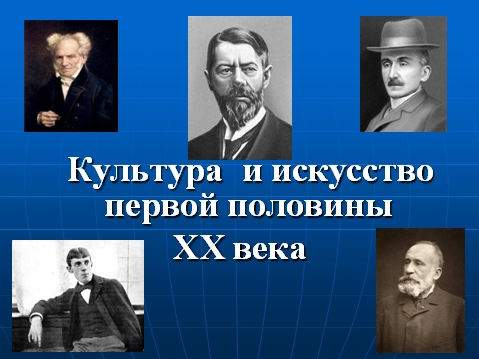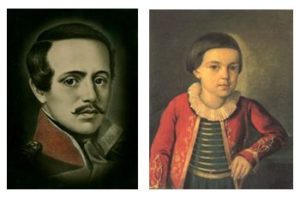history-master
It is the sanctuary of God’s people.
I offer a lesson summary that will help to acquaint students with the development of art culture in the first half of the X century. This is a lesson in learning new material.
Goals:
acquaint students with the main directions of culture and art in the first half of the XX century;
- get acquainted with the main achievements of culture of the first half of the XX century;
develop the ability to analyze information, be able to express their thoughts, express themselves
Equipment: presentation, computer, multimedia board
Methods: conversation, story
Contents
Class progress
1. Org. lesson start.
2. Checking homework
3. Communication of the topic and objectives of the lesson.
— In our previous lessons, we studied the development of many European and Eastern countries. Today we will talk about the development of culture, get acquainted with the main directions of the development of culture and art of the first half of the XX century.
(Slide 3)
Lesson plan:
- A revolution in natural science.
- Features of artistic culture.
- Symbolism
- Literature
4. Studying new material.
(1) the teacher's account:
(Slide 4 - 5)
- At the turn of the XIX - XX century, new discoveries appeared in solving the mysteries of the microcosm. The discovery of elementary particles and penetration into the secrets of matter was already called a revolution in natural science, since they led to a revision of the previous ideas about matter and the universe as a whole.
- During the first third of the XX century, scientists penetrated into the mystery of the structure of the atom (the electron, proton, positron and neutron were discovered) and by the end of the 1930s came to the practical development of atomic energy.
- Einstein’s theory of relativity changed our understanding of space, time and motion.
(Slide 6)
In the first half of the XX century, the foundations of the science of genetics were laid. Microbiology and the pharmaceutical industry have made great strides.
- The classical (Newtonian) scientific picture of the world was replaced by a new, non-classical picture of the world. In it, a special place is given to randomness (indeterminism): a person is a grain of sand in the world of random atoms, at the same time, the description of the world picture depends on the position of a person.
- The works of supporters of the philosophy of life A. Schopenhauer and F. Nietzsche became popular. They called for the recognition of irrational (inaccessible to reason) aspects of mental behavior and human behavior.
(Slide 7)Sigmund Freud’s work on psychoanalysis is gaining popularity, and its significance has gone far beyond psychotherapeutic treatment.
The doctrine of unconscious motives and instincts became not only a method of restoring the mental balance of patients, but also the tools of artistic creativity. His teachings formed the basis of many works on philosophy, history, art and literature.
(Slide 8)Of great importance for understanding the features of artistic creativity and cognition was the teaching of the French philosopher A. Bergson.
(Slide 9)In Europe and the United States, sociology is becoming popular - the science of the development of society and social behavior of people. Work is becoming popular
Mm. webera
(Slide 10)At the beginning of the 20th century, the problems of studying human consciousness were posed differently. In the late 19th and early 20th centuries in Europe and the USA, sociology was developed – the science of various aspects of the development of societies and social behavior of people.
2. Features of artistic culture.
(Slide 11) Culture of the first half of the XX century can be divided into 3 periods.
1 period (1900-1914):
- It's called decadence -- decline.
- Crisis is an element of growth, development, combining the dying away of the old and the birth of the new.
- Time of highs, talents, new ideas
2 period of the 20-30s:
- Completely new phenomena and events had an impact;
- Fascism and the growing threat of war contributed to the outflow of the creative intelligentsia
- The world moved to New York.
Art historians date the beginning of a new period in the development of culture from the late 1880s, which was called “modernism” (modern), and its end is considered conditionally 1960s. But culture does not stand still, but is constantly developing and there are many directions that we will now get acquainted with.
(Slide 12)The conclusions of the new era and ideological searches formed the basis of a new trend - neo-romanticism, which sought to synthesize and comprehend the past of European and world culture.
Symbolism
(Slide 13)one of the largest trends in art (in literature, music and painting), which arose in France in the 1870s-80s and reached its greatest development at the turn of the XIX and XX centuries, primarily in France, Belgium and Russia. Symbolists radically changed not only different types of art, but also the very attitude towards it. Their experimental character, drive for innovation, cosmopolitanism and wide range of influences have become a model for most contemporary arts. Symbolists used symbolism, understatement, hints, mystery, mystery. The main mood captured by the symbolists was pessimism, reaching to despair. Everything “natural” seemed to be only “appearance”, which had no independent artistic significance.
(Slide 14)The pioneers in this direction in music were R. Wanger, in literature – S. Baudelaire, P. Verlaine, S. Mallarme.
(Slide 15)The symbolism has its own characteristics:
1) It involves the combination of the real and the mysterious, the social and the individual, the appeal to myths, the search for mystical revelation.
2) It's basically a symbol.
(3) The centre was the cult of the Eternal Feminine as a symbol and earthly image of the highest perfection.
(Slide 16)In the visual arts, symbolism is represented by the following artists: Audrey Beardsley (England)
(slide 17)) Puvy de Chavannes (France)
(Slide 18)Gustav Klimt
(Slide 19)Arnold Böcklin
(Slide 20-21)
- At the beginning of the 20th century, a new type of synthetic art – cinema – begins to acquire great popularity. Movie stars by Andre Deed. Max Linder Charles Chaplin, Mary Pickford have gained worldwide popularity. Cinema became a mass art and part of the emerging mass culture.
(Slide 22)The first direction of painting of modern times wasimpressionismThe direction that appeared in the last third of the XIX century, seeking to convey the elusive changes in nature, the movement of light in the air, was written in fractional strokes.
The bright representatives of this direction are
(Slide 23)Edouard Mane
(Slide 24)Edgar Dega
(Slide 25-26)Auguste Renoir
(Slide 27-28)Camille Pissarro
(Slide 29-30)Claude Monet
(Slide 31)Further searches in the visual arts led to the emergence of post-impressionism.
(Slide 32)The largest representative of this trend was V. Van Gogh,(Slide 33-34)Paul Cézanne,(Slide 35)Paul Gauguin
(slide 36)) Cubism- avant-garde direction in painting of the early XX century, whose representatives depicted the world in the form of geometric signs and compositional structures, deforming the appearance of real objects
(Slide 37)Representatives of the direction of cubism were the French artist P. Picasso and J. Braque. Representatives of cubism depicted the world in the form of geometric signs and compositional structures, deforming the appearance of real objects.
(Slide 38)The current in French painting of the early XX century, which is based on bright contrasting colors.
(slide 39)) - representatives
(Slide 40) Expressionism.The artistic direction of the XX century, which is characterized by a subjective perception of reality, a deformed image of the real world, hypertrophy of experiences and intoxication with despair
(Slide 41)representatives
(Slide 42) Neo-primitivism- is characterized by interest in the East, children's creativity, self-taught art, ancient rock painting.
The masters of this direction are professional artists who consciously turned to primitive forms of art. Among them, a special place is occupied by A. Russo, N. Pirosmanashvili, M.F. Larionov, N.S. potcharov and others.
(Slide 43) Abstract expressionismA peculiar contribution of Russian art to the world avant-garde. Founder - V.V. Kandinsky. This direction is characterized by the rejection of the image of real objects and the creation of an image based on self-sufficient expressiveness of color. Lines, shapes.
(Slide 44) Suprematism.One of the trends of abstract art, belongs to the type of geometric abstraction.
(Slide 45) Dadaism- an extreme avant-garde current. It is characterized by the denial of existing forms of art, the use of collage techniques, the creation of absurd works.
(Slide 46) SurrealismAvant-garde current in the art of the XX century, whose representatives turned to dreams, automatic consciousness, subconscious.
4. Literature
Page. 131 - 132
5. Summary of the lesson

{module Google_kvadrat}
The presentation contains 48 slides. Download lesson summary and presentation, volume of 2.6 MB, you can absolutely free



